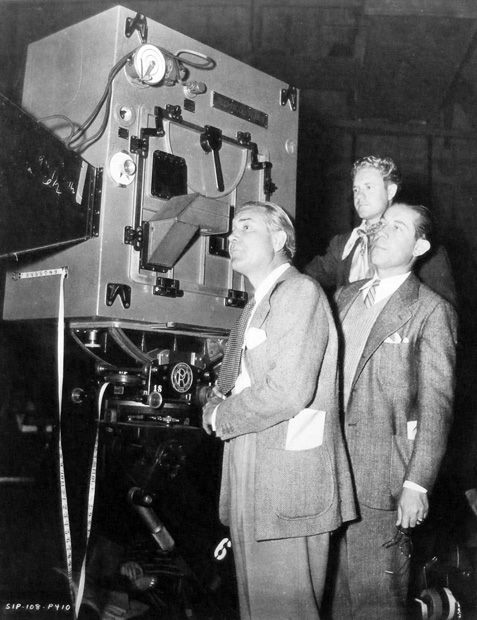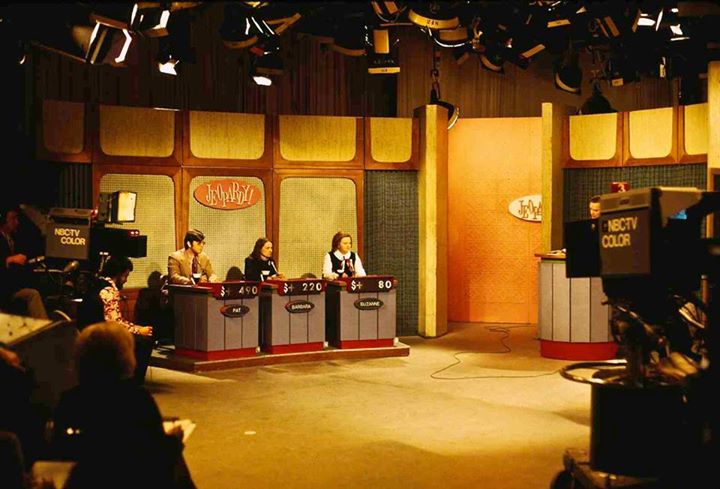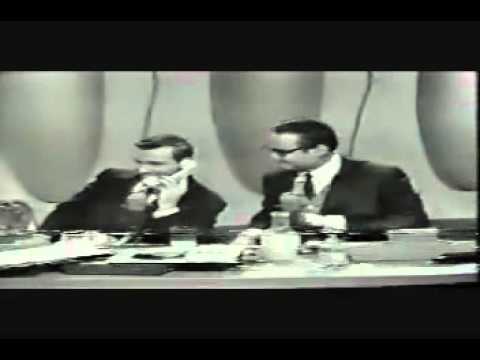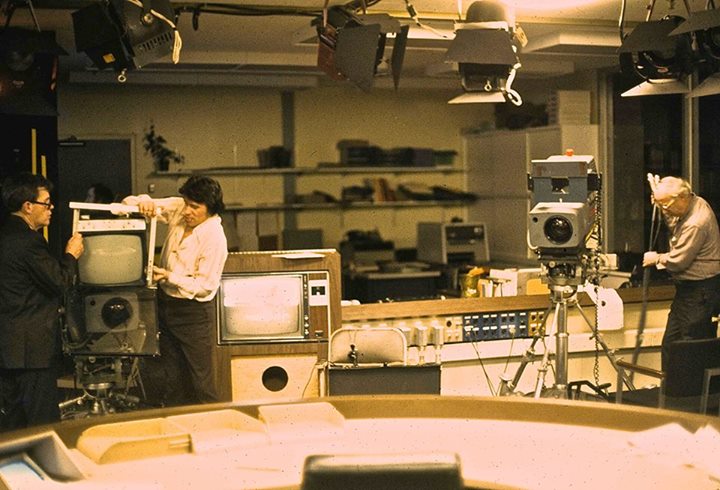- Home
- TV History
- Network Studios History
- Cameras
- Archives
- Viewseum
- About / Comments
Skip to content








































Posts in Category: TV History
Page 104 of 136
« Previous
1
2
3
4
5
6
7
8
9
10
11
12
13
14
15
16
17
18
19
20
21
22
23
24
25
26
27
28
29
30
31
32
33
34
35
36
37
38
39
40
41
42
43
44
45
46
47
48
49
50
51
52
53
54
55
56
57
58
59
60
61
62
63
64
65
66
67
68
69
70
71
72
73
74
75
76
77
78
79
80
81
82
83
84
85
86
87
88
89
90
91
92
93
94
95
96
97
98
99
100
101
102
103
104
105
106
107
108
109
110
111
112
113
114
115
116
117
118
119
120
121
122
123
124
125
126
127
128
129
130
131
132
133
134
135
136
Next » I Think Humongous Is The Word…
On October 9, 2013
- TV History
I Think Humongous Is The Word…
Standing beside one of the Technicolor cameras on the set of ‘Gone With The Wind’ is director Victor Fleming, camera operator Arthur Arling and cinematographer Ernest Haller. When this movie was in production, there were only about 6 or 7 of these cameras in existence and Fleming used all of them for the burning of Atlanta scenes. All together, I don’t think there were but about 30 of these cameras made for world wide use. The blimp housing is said to have weighed around 220 pounds. Add another 100 for the camera and you’ve got a hernia.
Roll Credits For ’60 Minutes’
On October 9, 2013
- TV History
Roll Credits!
This photo taken in Studio 45 shows the ’60 Minutes’ credit roll board around 1973. This is how it was done in “the old days”. Thanks to Glenn Mack for the photo.
Up Close And Personal…The EMI 2001 Color Camera Video
On October 9, 2013
- TV History
Up Close And Personal…The EMI 2001 Color Camera
The only place most of us in the US have ever seen this camera was in the movie ‘Network’, but the BBC workhorse for many years beginning around 1966. Heres a close look thanks to Troy Walters in Australia.
https://www.youtube.com/watch?feature=player_embedded&v=mnE10CnLF5E
BBC Studio N, Manchester was the North West of England’s news studio in Piccadilly, Manchester until 1981 when it moved to NBH, Oxford Road, Manchester. In M…
CBS Broadcast Center Studios
On October 8, 2013
- TV History
CBS Broadcast Center Studios
Here is the layout of the studios at the Broadcast Center in New York. This is a great mental guide when discussing where shows came from as we will in some posts above.
This is the Sony BVH 500 Video Recorder
On October 6, 2013
- TV History
I’ve Never Seen Anything Remotely Like This! Take A Look!
This is the Sony BVH 500 one inch, portable video tape recorder. Notice that the tape reels are stacked on top of each other! One reel spins one way and the other reel spins the other way! Amazing!
http://www.youtube.com/watch?v=TEdGo1eGYEw
http://www.thegeekgroup.org – Chris and Kidwell investigate and old Sony Reel to Reel VTR. They explore the different parts, figure how to load the tape, and…
MAGNIFICENT!
On October 4, 2013
- TV History
MAGNIFICENT!
Thanks to Glenn Mack for this fantastic photo taken during a rehearsal of ‘The Doctors’ around 1972. Although the RCA TK44A was introduced in 1968 and the better ‘B’ model in 1971, the TK41s could still hold their own and were still in service in some NBC NY studios as late as ’73 including studios 3A and 3B where this show came from. Originally, ‘The Doctors’ was not supposed to be a conventional soap opera. It first aired in 1963 for a trial run as an anthology series with self-contained episodes about medical emergencies. When the show was brought back in 1964, the show adopted a serial form of storytelling. NBC aired the show in the 2:30 p.m. Eastern slot in between ‘Days of our Lives’ and ‘Another World’, two highly rated shows. ‘The Doctors’ took over the time slot that had been used by Merv Griffin on his first daytime talk show, and remained in the 2:30pm timeslot for nearly sixteen years. This is an extraordinary feat for daytime shows of its day, especially since some of its victims in the ratings were long-running favorites such as CBS’ ‘House Party with Art Linkletter’ and ABC’s ‘Dating Game’. The longest-running soap opera in television history, CBS Daytime’s ‘The Guiding Light’, also competed against The Doctors on several occasions. The show went color in 1966. This show is not connected to the current ABC soap by the same name.
CLASSIC! RCA TK41s In Action At NBC Brooklyn Studios
On October 2, 2013
- TV History
CLASSIC! RCA TK41s In Action At NBC Brooklyn Studios
At 12:58 and 23:35, you’ll see the great RCA TK41s in action at NBC Brooklyn. The date was March 13, 1966 and the production was ‘The Bell Telephone Hour’. That episode was ‘The Music Of The Movies’ and in the clip you’ll see (Oz scarecrow) Ray Bolger and a young Peter Marshall. This rare footage is from an interesting AT&T film that touts the reliability of their services to all types of industries. Enjoy!
http://www.youtube.com/watch?v=ZAJpionUxJ8
For more from the AT&T Archives, visit http://techchannel.att.com/archives This film focuses on the integrity and reliability of the entire Bell System netwo…
’60 Minutes’ From Above…Glenn Mack Photo
On October 1, 2013
- TV History
’60 Minutes’ From Above…Glenn Mack Photo
Taken on the catwalk, this shot is looking down on the ’60 Minutes’ green screen set that we saw yesterday. The camera may be a Norelco PC60 (instead of a PC70) as it looks like it has two cables going to it. How clever is that old TD 1 pedestal that has been converted into a monitor stand?

Live – From Coast to Coast!
On October 1, 2013
- TV History
Transcontinental Television History
Here’s another great article from our friend Richard Wirth. The original “broadband” and much more are covered in this write up of how AT&T made coast to coast television possible. The videos are very good too, so take a look! Thanks Richard!
http://provideocoalition.com/pvcexclusive/story/live-from-coast-to-coast
Today, we think nothing of clicking our remote and have live images from somewhere else in the world appear on the screen. Push a few buttons on our computer and loved ones living far away appear. But in television’s early days, a live program meant we were watching a local program.
The ’60 Minutes’ Set…Another Glenn Mack Photo
On September 30, 2013
- TV History
The ’60 Minutes’ Set…Another Glenn Mack Photo
At first glance, this looks like it could be a Betty White, Tim Conway sketch about a pregnant granny, but, it’s not. The is the famous green screen set on ’60 Minutes’ in the early 1970s. As you’ll see tomorrow, the camera is a Norelco PC70. According to Glenn, the ‘Captain Kangaroo’ set is behind him on the other wall.
Another Great Glenn Mack Photo!
On September 29, 2013
- TV History
Another Great Glenn Mack Photo!
From 1964 till 1975, Art Fleming hosted Jeopardy! in NBC Studio 8G at 30 Rock. The game board would be at the far right and it appears that the RCA TK44 on the left is shooting it from across the studio (you can see the layout in the clip below). The original daytime version aired on NBC from March 30, 1964 to January 3, 1975, then spawned a weekly nighttime syndicated edition that aired from September 9, 1974 to September 5, 1975, and was later revived as The All-New Jeopardy!, which ran from October 2, 1978 until March 2, 1979. Both NBC versions and the weekly syndicated version were hosted by Art Fleming. Don Pardo served as announcer until 1975, and John Harlan announced for the 1978–79 show.
‘Star Trek’…Intro To The Second Pilot, Unaired
On September 29, 2013
- TV History
‘Star Trek’…Intro To The Second Pilot, Unaired
This may be the only show that had two different pilot episodes. This is the opening from the second pilot ‘Where No Man Has Gone Before’ and this segment was never aired, but, the rest of this pilot did air as the third episode that had the new opening and theme music added.
In Roddenberry’s original concept, the lead character was Captain Robert April of the starship S.S. Yorktown. This character was developed into Captain Christopher Pike, first portrayed by Jeffrey Hunter in the first pilot called ‘The Cage’.
Roddenberry first presented Star Trek to CBS, which turned it down in favor of the Irwin Allen creation Lost in Space. He next presented his concept to the head of Desilu Studio, Herb Solow, who accepted it. Solow then successfully sold the show to NBC which paid for, but turned down, the first pilot stating that it was “too cerebral”. However, the NBC executives were still impressed with the concept, and they understood that its perceived faults had been partly because of the script that they had selected themselves. NBC made the unusual decision to pay for a second pilot, using the script called “Where No Man Has Gone Before”. Only the character of Mr. Spock, played by Leonard Nimoy, was kept from the first pilot, and only two cast members, Majel Barrett and Nimoy, were carried forward into the series. This pilot proved to be satisfactory to NBC, and the network selected Star Trek to be in its upcoming television schedule for the fall of 1966.
The second pilot introduced the rest of the main characters: Captain Kirk (William Shatner), chief engineer Lt. Commander Scott (James Doohan) and Lt. Sulu (George Takei), who served as a physicist on the ship in the second pilot but subsequently became a helmsman throughout the rest of the series. Ship’s doctor Leonard McCoy (DeForest Kelley) joined the cast when filming began for the first season, and he remained for the rest of the series, achieving billing as the third star of the series. Also joining the ship’s permanent crew during the first season was the communications officer, Lt. Uhura (Nichelle Nichols), the first African-American woman to hold such an important role in an American television series.
https://www.youtube.com/watch?v=GFtc2Ypwzl0
The original print from Star Trek’s 2nd pilot was never aired in this format. Had different opening narration, credits, had acts 1 thru 4 like an old quinn m…
SUPER RARE! 3 ‘Tonight Show’ Hosts In One Minute
On September 28, 2013
- TV History
SUPER RARE! 3 ‘Tonight Show’ Hosts In One Minute
Steve Allen and Johnny Carson pull a fast one on Jack Paar with a prank call. Carson was already hosting ‘Tonight’ and was taping for a week or so in Los Angeles when he appeared on ‘The New Steve Allen Show’ (1962-64) which was in syndication through Westinghouse. Prior to this episode, Allen placed a telephone call to the home of Johnny Carson, posing as a ratings company interviewer, asking Carson if the Television was on, and what program he was watching. Carson didn’t immediately realize the caller was Allen, and the exchange was classic humor from both, beginning to end. A rarity is the exchange between Allen and Carson about Carson’s guests, permitting him to plug his own show on a competing network.
https://www.youtube.com/watch?v=Bex4_9J2ij4
One of my favorite moments in TV History is when Johnny Carson appeared on The Tonight Show with Steve Allen. Steve and Johnny decided to call Jack Paar’s ho…
Another Rarity: TK60s At NBC Burbank
On September 27, 2013
- TV History
Another Rarity: TK60s At NBC Burbank
Compared to others, these cameras had a short life in Burbank. The earliest they could have been bought was late 1962 and with NBC taking the lead to go all color in 1965, they would have been obsolete and sold off. This shot is from a Bob Hope special taping sometime between 1963 and 1965 in Studio 2. Since Hope produced his own shows, he did them in b/w to save money until the 1965 color mandate at NBC. As I understand it, Studios 1 and 3 were color and Studios 2 and 4 were black and white. I don’t recall ever seeing a TK60 at NBC New York, do you?
‘$64,000 Question’, 1st Anniversary Show, June 7, 1956
On September 27, 2013
- TV History
‘$64,000 Question’, 1st Anniversary Show, June 7, 1956
The $64,000 Question premiered June 7, 1955 on CBS-TV, sponsored by cosmetics maker Revlon and originating from the start live from CBS-TV Studio 52 in New York (later the disco-theater Studio 54). The first contestant on the show was Thelma Farrell Bennett, a housewife from Trenton, New Jersey who failed to make it to the first plateau but won a 1955 Cadillac convertible.
To increase the show’s drama and suspense, it was decided to use an actor rather than a broadcaster as the host. Television and film actor Hal March, familiar to TV viewers as a supporting regular on ‘The George Burns and Gracie Allen Show’ and ‘My Friend Irma’, found instant fame as the quiz show’s host, and Lynn Dollar stood nearby as his assistant.
‘The $64,000 Question’ had its roots in the CBS radio quiz show, ‘Take It or Leave It’, which followed in the wake of the pioneering ‘Professor Quiz’ (radio’s first quiz program) and ‘Uncle Jim’s Question Bee’ (the second radio quiz show). ‘Take It or Leave It’ ran from April 21, 1940 to July 27, 1947. It was first hosted by Bob Hawk (1940–41), followed by Phil Baker (1941–47). In 1947, the series switched to NBC, hosted at various times by Baker, Garry Moore (1947–49), Eddie Cantor (1949–50) and Jack Paar (beginning June 11, 1950). On September 10, 1950, ‘Take It or Leave I’t changed its title to ‘The $64 Question’. Paar continued as host, followed by Baker (March–December 1951) and Paar (back on December 1951). The series continued on NBC Radio until June 1, 1952.
http://www.youtube.com/watch?v=dl8h6GtF5Qg
Hal March hosts the show that awards large sums of money to contestants that answer complex questions..
Super Rare…’Masquerade Party’, May 22, 1955
On September 25, 2013
- TV History
Super Rare…’Masquerade Party’, May 22, 1955
Only five episodes are known to exist of this show that I remember watching as a kid. From 1952-1960, the show aired on ABC, NBC and CBS at various times and had six different hosts. To my amazement, one host was none other than CBS newsman Douglas Edwards in 1953! The other hosts were Bud Collyer (1952), Peter Donald (1954–1956), Eddie Bracken (1957), Robert Q. Lewis (1958) and Bert Parks (Fall 1958–1960). You won’t believe who the second guest is with that great scottish accent! The announcer is Johnny Olson and one of the producers was Alan Sherman who also worked on ‘What’s My Line’.
http://www.youtube.com/watch?v=owpsw5l4t2M
A panel of celebrities try to guess the identity of another celebrity that is in heavy makeup and/or costume..A 1950’s classic game show!..Hosted by Peter Do…
The Truth About Bert And Ernie! Ever wonder how Ernie could use both hands?
On September 24, 2013
- TV History
The Truth About Bert And Ernie!
Ever wonder how Ernie could use both hands? Now we know! Here’s Jim Henson (center) with Ernie and Richard Hunt who’s working the right hand. Occasionally, Frank Oz (right) and Bert would use both hands which required another puppet. As always, they are watching the monitor in even the rehearsals like this. To the left is their “stage” that the Muppets would appear above while it hid the puppet masters.
The EMI 203 Camera In Action
On September 23, 2013
- TV History
The EMI 203 Camera In Action
Although EMI cameras were ultra rare in the US, they were quite common many other countries, and staples at the BBC. Debuting in 1960, the 203 was a five lens monochrome camera that could use either 4.5 or 3 inch Image Orthicons and make pictures for 405, 525 or 624 line systems.
http://www.youtube.com/watch?v=B-MLpBW0gAY
EMI B&W Television camera, shown in a segment from the children’s show “Dodli” shot in 1977 at the Instructional Television Center in Tel Aviv
ULTRA RARE EXCLUSIVE! View From Behind Walter Cronkite’s Desk!
On September 20, 2013
- Archives, TV History
If you have ever wondered what Walter Cronkite saw from his desk, wonder no more. Thanks to Glenn Mack, here is a shot from behind that famous desk in the newsroom at the CBS Broadcast Center from around 1974. It appears that the two Norelco PC70s are in the process of having their teleprompters changed to newer models. It looks like both cameras are mounted on height adjustable tripods that were usually found only on movie sets, perhaps made by Movieola. Anyone know?
Poetry In Motion! .RCA TK47s In Action
On September 20, 2013
- TV History
Poetry In Motion! Must See…RCA TK47s In Action
Shot by an audience member in June of 1988 at PTL Club taping, you can see the fluid movement of these 4 cameras. 2 are mounted on Vinten Tern pedestals and 2 are on Vinten Fulmars.
http://www.youtube.com/watch?v=ZsW4UUcH5S4
In this 3rd video I’ve uploaded which relates specifically to the Heritage USA TV studio, I had to cut the video short. As with a number of my old videos sto…
Page 104 of 136
« Previous
1
2
3
4
5
6
7
8
9
10
11
12
13
14
15
16
17
18
19
20
21
22
23
24
25
26
27
28
29
30
31
32
33
34
35
36
37
38
39
40
41
42
43
44
45
46
47
48
49
50
51
52
53
54
55
56
57
58
59
60
61
62
63
64
65
66
67
68
69
70
71
72
73
74
75
76
77
78
79
80
81
82
83
84
85
86
87
88
89
90
91
92
93
94
95
96
97
98
99
100
101
102
103
104
105
106
107
108
109
110
111
112
113
114
115
116
117
118
119
120
121
122
123
124
125
126
127
128
129
130
131
132
133
134
135
136
Next »